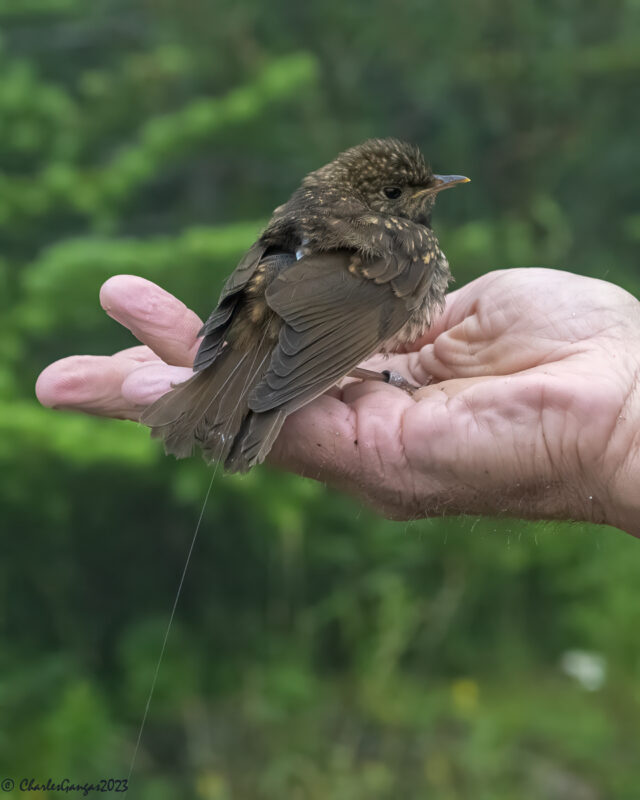
VCE’s first mist-netted juvenile Bicknell’s Thrush of 2023, equipped with a lightweight nanotag backpack to track its upcoming southward migration (and, we hope, its return northward flight next spring). 18 Jul 2023, Mt. Mansfield. © Charles Gangas
As has been the case so often during this soggy summer, VCE biologists dodged downpours and sat out showers on the Mansfield ridgeline through the first 3 weeks of July. The torrential rains that wrought havoc on so many Vermonters kept the VCE banding team at bay for >10 days — though we seriously contemplated a post-deluge backpack ascent, in the spirit of last summer’s grueling trek, we feared extremely wet, if not hazardous, trail conditions. So, we compensated with a visit of two consecutive nights on 17-18 July, despite a forecast for yet more showers. Arriving in early evening on the 17th, our small contingent of 5 confirmed the meterologists’ accuracy, as skies opened up and forced our retreat to the Vail ski patrol hut. By 7:00 pm, rain had stopped, so we donned rubber boots and headed upslope to open our 30 nets. We were able to band until dusk and reopen at dawn the following morning, though moisture-laden clouds continued to swirl across the ridgeline. Mist net captures were steady, if not heavy — we banded free-flying juveniles of 8 species, several adults in early stages of flight feather molt, and our third Sharp-shinned Hawk of the season. A female Hairy Woodpecker may have been our most surprising bird, but juvenile juncos ruled the day, comprising nearly 50% of all captures.
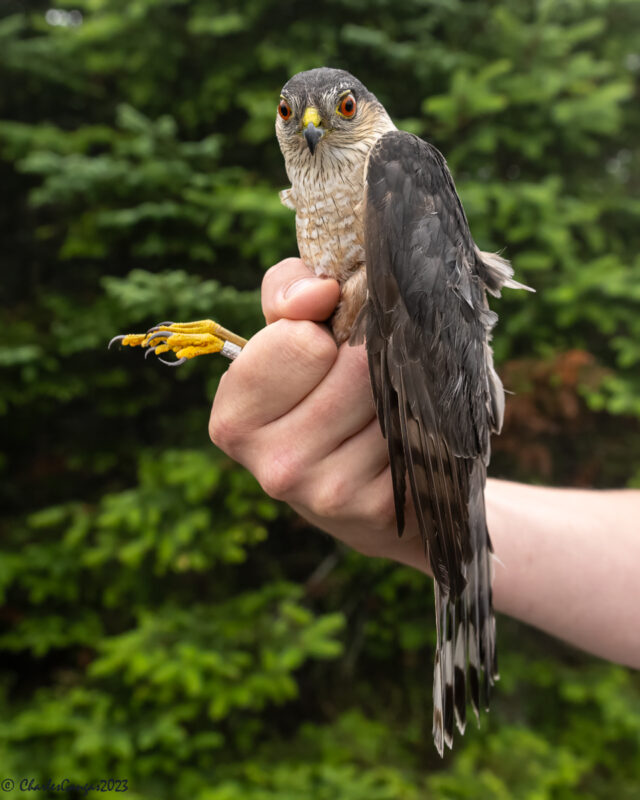
An adult male Sharp-shinned Hawk, the third individual banded by VCE on Mansfield so far this summer. 19 July 2023. © Charles Gangas
Our final tally of 86 captures included:
Sharp-shinned Hawk — 1 adult male
Hairy Woodpecker — 1 adult female
Golden-crowned Kinglet — 3 (1 adult female, 2 juveniles)
Brown Creeper — 1 adult of unknown sex
Winter Wren — 3 (2 adults, 1 juvenile)
Bicknell’s Thrush — 9 (4 males, 3 females (1 return from 2018), 2 juveniles)
Swainson’s Thrush — 2 (adult female, juvenile)
American Robin — 2 (adult female, juvenile)
Dark-eyed Junco (Slate-colored) — 39 (2 adults, 37 juveniles)
White-throated Sparrow — 3 (1 male, 2 females)
Ovenbird —1 adult of unknown sex
Magnolia Warbler — 2 adult males, one a yearling midway through primary molt
Blackpoll Warbler — 14 (7 males, 4 females, 3 juveniles)
Black-throated Blue Warbler — 1 adult female
Yellow-rumped Warbler (Myrtle) — 3 (1 adult male, 2 juveniles)
Black-throated Green Warbler — 1 adult male
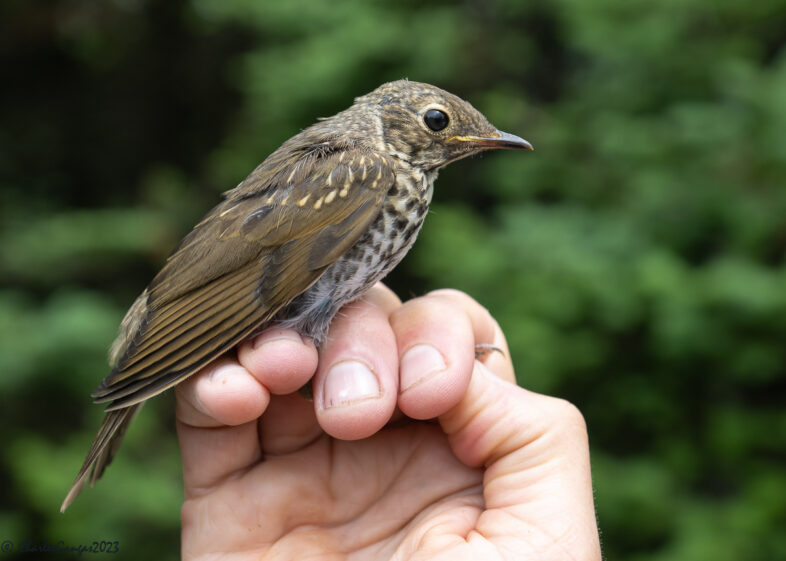
A mist-netted juvenile Swainson’s Thrush, distinguishable from Bicknell’s in this short-lived plumage mainly by its prominent buffy eye-ring. © Charles Gangas
We were pleased to capture and attach miniaturized nanotags to 2 juvenile Bicknell’s Thrush (BITH), but for the second consecutive week, an adult female BITH provided our uncontested research high point. We captured #2821-79238 in a Long Trail mist net early on the morning of 18 July. The short antenna protruding from her back feathers caused the heart of yours truly to skip a beat, while her regressing brood patch indicated that she had completed nesting and was likely tending fledglings. We had encountered #2821-79238 only twice previously — first when we banded her on 7 July 2021 and gingerly affixed GPS tag #50490 to her back; second when we recovered her on 28 June 2022, removed backpack 50490 and replaced it with recharged tag #50471. Back at the VCE banding “lab” in Parking Lot A, we excitedly snipped the elastic bands that had held her tag snugly in place for the past year. GPS technical guru Kevin Tolan quickly went to work on his laptop to reveal what goldmine of data our third encounter with #2821-79238 might yield.
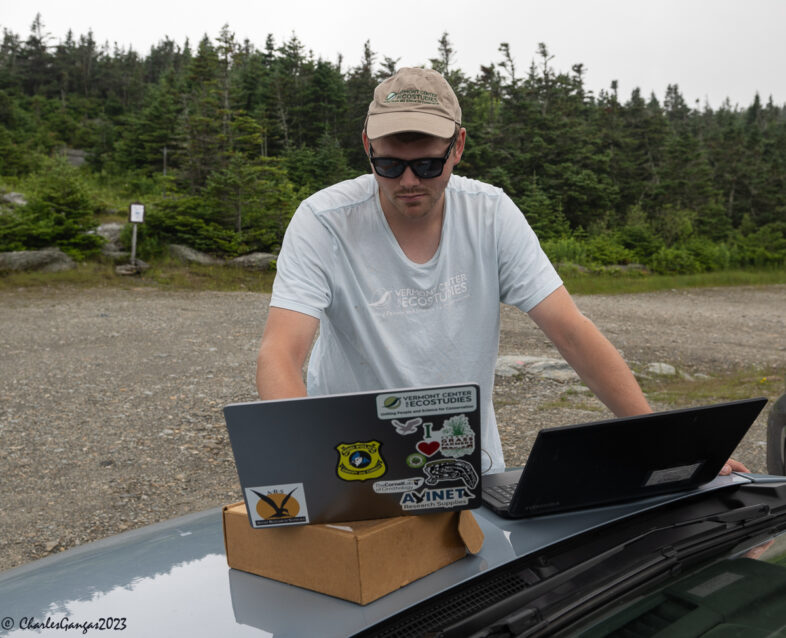
VCE’s Kevin Tolan downloading GPS track data from Bicknell’s Thrush female #2821-79238 shortly after her recapture and backpack retrieval. Her GPS tag yielded 18 fixes that confirmed remarkable consecutive-winter fidelity to a 2.5-acre territory in Cuba’s remote Sierra Maestra. © Charles Gangas
Moments later, we exchanged broad grins and high fives as Kevin confirmed that #2821-79238 had not only provided us with 18 solid “fixes” (precise GPS locations) between 15 August 2022 and 19 February 2023, but that she had returned to the identical overwinter territory in Cuba’s remote Sierra Maestra cloud forests. Moreover, she had followed a very similar southward trajectory in both autumns, with October stops in the mid-Atlantic between New Jersey and Maryland before striking out over open water for the Greater Antilles. Her tiny overwinter territory of 2.5 acres (1 hectare; similar in size to territories we documented via radio telemetry in the DR) was concentrated at an elevation of 1,550 m in the pristine cloud forests 26 km due east of Pico Turquino, where VCE conducted field surveys during the winters of both 2017 and 2018. She remains the only individual of the 22 GPS-tagged BITH we have so far tracked who overwintered in Cuba. All others have occupied territories either in the DR (18) or Haiti (3). And, the very few birds (3, to be exact) who have provided consecutive-winter data — including #2821-79238 and the high-altitude female from the DR’s Pico Duarte — have shown exceptional site fidelity.
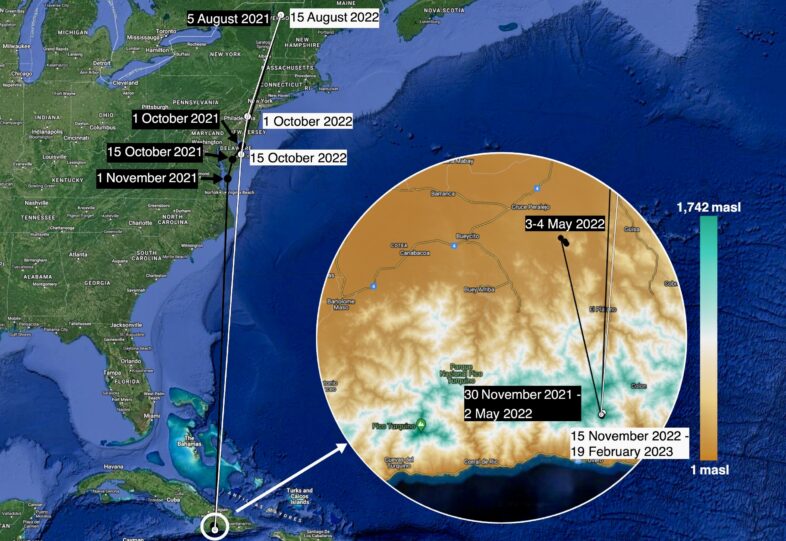
The remarkably similar autumn migratory tracks and identical overwintering sites of Bicknell’s Thrush female #2821-79238 in 2021-22 (black) and 2022-23 (white). Note that individual points depict exact locations, while lines connecting points indicate presumed pathways. Image courtesy of Kevin Tolan.
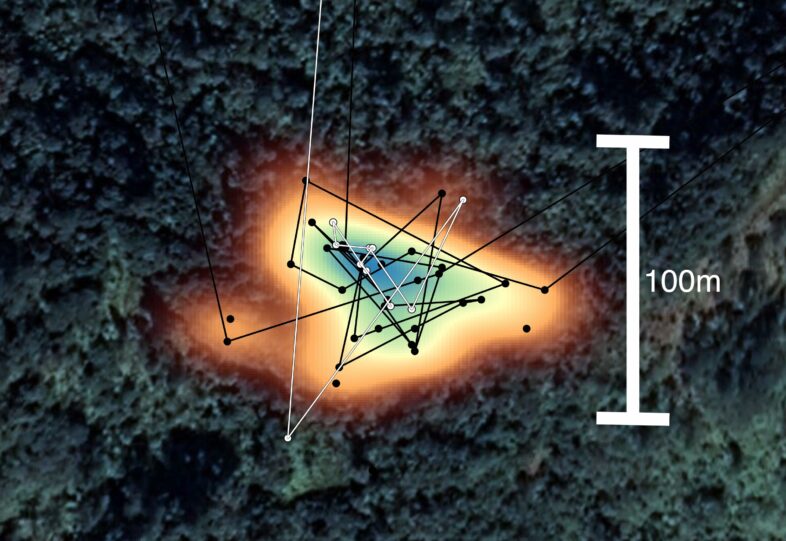
The 2021-22 and 2022-23 winter movements of female Bicknell’s Thrush #2821-79238, at 1,550 m (5,085 ft) elevation in Cuba’s Sierra Maestra, 26 km east of Pico Turquino, the island’s highest peak at 1,974 m (6,476 ft). The bird occupied the identical cloud forest territory of ~2.5 acres (1 hectare) in both winters. Image courtesy of Kevin Tolan.
Returning to Mansfield, we’ve so far captured 52 individual BITH in 2023: of 50 adults, 20 have been newly-banded birds and 30 returns from previous years. This return rate of 60% is astonishing, and highlights the site tenacity of BITH at both ends of its migratory range. The adult sex ratio continues to be highly male-biased, with males (40) outnumbering females (11) nearly 4:1 in our 2023 captures to date (the long-term average is ~2.2 males per female). For context, at this juncture of the 2022 field season, we had captured 60 individual BITH, of which 43 were males and 17 females, a more “typical” sex ratio of 2.5:1. However, only 25 of our 60 (42%) adult BITH captures in 2022 were birds banded in a previous season, a much lower return than we’ve documented this summer. Such between-year population-level differences underscore the importance of VCE’s long-term monitoring.
With only two full weeks remaining in our 32nd summer field season on Mansfield, we of course hope to recover additional GPS backpacks, affix our remaining 10 nanotags to BITH before they migrate south, capture solid numbers of free-flying juveniles of all locally-breeding species, and find a surprise or two in our nets. Stay tuned for updates.
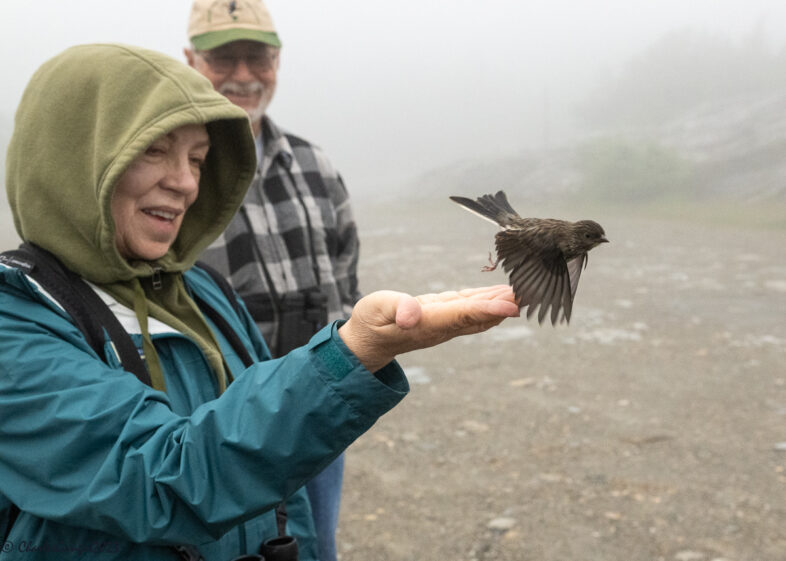
Dawn Freeman releases one of 37 juvenile Slate-colored Juncos banded by VCE on Mansfield 17-19 July 2023, as fellow birder Barry Blust enjoys the show. © Charles Gangas

Just to say these reports become more enlightening (re VCE’s monumental Bicknell’s study), and thus more exciting, with each iteration! 2 more weeks GROAN, too soon to end!Thank you, Veer Frost
The similarities between the 2021-2022 and 2022-2023 autumn migratory tract and overwintering site is astonishing! It’s so exciting to see the data coming out of this study. I’m optimistic that it will better the chances of the Bicknell Thrush’s survival. Thank you for that.
Thanks for your tireless work and the reports that keep us entertained and informed.